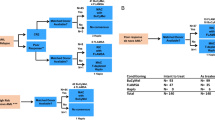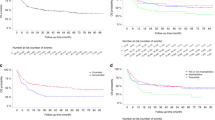Summary:
Adult patients with acute lymphoblastic leukaemia (ALL) have been treated according to national protocols in Sweden since 1986. Stem cell transplantation (SCT) has been recommended in first remission for patients with risk factors for relapse, and for standard risk patients only after relapse. In this retrospective study, the results of autologous and allogeneic SCT in these populations were evaluated. In total, 187 patients with a median age of 34 years (17–66 years) underwent SCT. The 5-year disease-free survival (DFS), for all patients, was 26% (Confidence intervals (CI) 20–32%). The 5-year DFS was higher for patients transplanted in first remission 32% (CI 24–40%) compared to 14% (CI 5–23%; P<0.0001) in patients transplanted beyond first remission. No significant differences in DFS (P=0.06) were determined between autologous, related donor and unrelated donor SCT in the whole cohort. A lower relapse rate was counterbalanced by higher treatment-related mortality in patients undergoing allogeneic SCT. In Philadelphia-positive ALL, allogeneic SCT was superior to autologous SCT, with a 5-year DFS of 30% (CI 12–47%) vs 0% (P=0.04). Limited chronic graft-versus-host-disease (GVHD) was associated with an improved DFS of 53% (CI 38–69%) compared to no chronic GVHD of 22% (CI 10–36%; P=0.0008), indicating a clinically important graft-versus-leukaemia effect.
This is a preview of subscription content, access via your institution
Access options
Subscribe to this journal
Receive 12 print issues and online access
$259.00 per year
only $21.58 per issue
Buy this article
- Purchase on Springer Link
- Instant access to full article PDF
Prices may be subject to local taxes which are calculated during checkout




Similar content being viewed by others
References
Faderl S, Jeha S, Kantarjian HM . The biology and therapy of adult acute lymphoblastic leukemia. Cancer 2003; 98: 1337–1354.
Goldstone AP, Prentice HG, Durrant J et al. Allogeneic transplant (related or unrelated donor) is the preferred treatment for adult Philadelphia chromosome positive (Ph+) acute lymphoblastic leukemia (ALL). Results from the International ALL Trial (MRC UKALLXII/ECOG E2993). Blood 2001; 98: 856a (abstract).
Gupta V, Yi QL, Brandwein J et al. The role of allogeneic bone marrow transplantation in adult patients below the age of 55 years with acute lymphoblastic leukemia in first complete remission: a donor vs no donor comparison. Bone Marrow Transplant 2004; 33: 397–404.
Dombret H, Gabert J, Boiron JM et al. Outcome of treatment in adults with Philadelphia chromosome-positive acute lymphoblastic leukemia – results of the prospective multicenter LALA-94 trial. Blood 2002; 100: 2357–2366.
Nordlander A, Mattsson J, Ringden O et al. Graft-versus-host disease is associated with a lower relapse incidence after hematopoietic stem cell transplantation in patients with acute lymphoblastic leukemia. Biol Blood Marrow Transplant 2004; 10: 195–203.
Zikos P, Van Lint MT, Lamparelli T et al. Allogeneic hemopoietic stem cell transplantation for patients with high risk acute lymphoblastic leukemia: favorable impact of chronic graft-versus-host disease on survival and relapse. Haematologica 1998; 83: 896–903.
Passweg JR, Tiberghien P, Cahn JY et al. Graft-versus-leukemia effects in T lineage and B lineage acute lymphoblastic leukemia. Bone Marrow Transplant 1998; 21: 153–158.
Schauer P, Arlin ZA, Mertelsmann R et al. Treatment of acute lymphoblastic leukemia in adults: results of the L-10 and L-10 M protocols. J Clin Oncol 1983; 1: 462–470.
Hallbook H, Simonsson B, Ahlgren T et al. High-dose cytarabine in upfront therapy for adult patients with acute lymphoblastic leukaemia. Br J Haematol 2002; 118: 748–754.
Hoelzer D, Ludwig WD, Thiel E et al. Improved outcome in adult B-cell acute lymphoblastic leukemia. Blood 1996; 87: 495–508.
Reiter A, Schrappe M, Tiemann M et al. Improved treatment results in childhood B-cell neoplasms with tailored intensification of therapy: a report of the Berlin–Frankfurt–Munster Group Trial NHL-BFM 90. Blood 1999; 94: 3294–3306.
Shulman HM, Sullivan KM, Weiden PL et al. Chronic graft-versus-host syndrome in man. A long-term clinicopathologic study of 20 Seattle patients. Am J Med 1980; 69: 204–217.
Przepiorka D, Weisdorf D, Martin P et al. 1994 Consensus Conference on Acute GVHD Grading. Bone Marrow Transplant 1995; 15: 825–828.
Doney K, Hagglund H, Leisenring W et al. Predictive factors for outcome of allogeneic hematopoietic cell transplantation for adult acute lymphoblastic leukemia. Biol Blood Marrow Transplant 2003; 9: 472–481.
Ringden O, Labopin M, Bacigalupo A et al. Transplantation of peripheral blood stem cells as compared with bone marrow from HLA-identical siblings in adult patients with acute myeloid leukemia and acute lymphoblastic leukemia. J Clin Oncol 2002; 20: 4655–4664.
Jamieson CH, Amylon MD, Wong RM, Blume KG . Allogeneic hematopoietic cell transplantation for patients with high-risk acute lymphoblastic leukemia in first or second complete remission using fractionated total-body irradiation and high-dose etoposide: a 15-year experience. Exp Hematol 2003; 31: 981–986.
Brisco J, Hughes E, Neoh SH et al. Relationship between minimal residual disease and outcome in adult acute lymphoblastic leukemia. Blood 1996; 87: 5251–5256.
Ciudad J, San Miguel JF, Lopez-Berges MC et al. Prognostic value of immunophenotypic detection of minimal residual disease in acute lymphoblastic leukemia. J Clin Oncol 1998; 16: 3774–3781.
Foroni L, Hoffbrand AV . Molecular analysis of minimal residual disease in adult acute lymphoblastic leukaemia. Best Pract Res Clin Haematol 2002; 15: 71–90.
Vidriales MB, Perez JJ, Lopez-Berges C et al. Minimal residual disease (MRD) in adolescent (>14 years) and adult acute lymphoblastic leukaemias (ALL): early immunophenotypical evaluation has high clinical value. Blood 2003; 101: 4695–4700.
Sebban C, Lepage E, Vernant JP et al. Allogeneic bone marrow transplantation in adult acute lymphoblastic leukemia in first complete remission: a comparative study. French Group of Therapy of Adult Acute Lymphoblastic Leukemia. J Clin Oncol 1994; 12: 2580–2587.
Thomas X, Boiron JM, Huguet F et al. Outcome of treatment in adults with acute lymphoblastic leukemia: analysis of the LALA-94 trial. J Clin Oncol 2004; 22: 4075–4086.
Horowitz MM, Messerer D, Hoelzer D et al. Chemotherapy compared with bone marrow transplantation for adults with acute lymphoblastic leukemia in first remission. Ann Intern Med 1991; 115: 13–18.
Zhang MJ, Hoelzer D, Horowitz MM et al. Long-term follow-up of adults with acute lymphoblastic leukemia in first remission treated with chemotherapy or bone marrow transplantation. The Acute Lymphoblastic Leukemia Working Committee. Ann Intern Med 1995; 123: 428–431.
Attal M, Blaise D, Marit G et al. Consolidation treatment of adult acute lymphoblastic leukemia: a prospective, randomized trial comparing allogeneic versus autologous bone marrow transplantation and testing the impact of recombinant interleukin-2 after autologous bone marrow transplantation. BGMT Group. Blood 1995; 86: 1619–1628.
Rowe JR, Richards SM, Burnett AK et al. Favorable results of allogeneic bone marrow transplantation for adults with Philadelphia-chromosome-negative acute lymphoblastic leukemia in first complete remission: results from the International ALL Trial (MRC UKALL XII/ECOG E2993). Blood 2001; 98: 481a (abstract).
Weisdorf D, Bishop M, Dharan B et al. Autologous versus allogeneic unrelated donor transplantation for acute lymphoblastic leukemia: comparative toxicity and outcomes. Biol Blood Marrow Transplant 2002; 8: 213–220.
Ottmann OG, Druker BJ, Sawyers CL et al. A phase 2 study of imatinib in patients with relapsed or refractory Philadelphia chromosome-positive acute lymphoid leukemias. Blood 2002; 100: 1965–1971.
Thomas DA, Faderl S, Cortes J et al. Treatment of Philadelphia chromosome-positive acute lymphocytic leukemia with hyper-CVAD and imatinib mesylate. Blood 2004; 103: 4396–4407.
Cornelissen JJ, Carston M, Kollman C et al. Unrelated marrow transplantation for adult patients with poor-risk acute lymphoblastic leukemia: strong graft-versus-leukemia effect and risk factors determining outcome. Blood 2001; 97: 1572–1577.
Gorin NC, Labopin M, Polge E et al. Risk assessment in adult acute lymphoblastic leukaemia before early haemopoietic stem cell transplantation with a geno-identical donor: an easy clinical prognostic score to identify patients who benefit most from allogeneic haemopoietic stem cell transplantation. Leukemia 2003; 17: 1596–1599.
Acknowledgements
We thank biostatistican Niclas Eriksson, Uppsala Clinical Research Center for statistical advice and Karin Hellström, the Oncology Centre in the Uppsala/Örebro region for data collection.
Author information
Authors and Affiliations
Consortia
Corresponding author
Appendix A
Appendix A
Participating centres in the Swedish Adult ALL Group:
Department of Haematology, Karolinska University Hospital, Huddinge; Department of Haematology, Karolinska University Hospital, Solna; Department of Haematology, University Hospital, Linköping; Department of Haematology, University Hospital, Lund, Section of Haematology and Coagulation, Department of Medicine, Malmö University Hospital, Malmö; Haematology Section, Department of Internal Medicine, Sahlgrenska University Hospital, Göteborg; Department of Medicine, Division of Haematology, University Hospital, Umeå; Department of Haematology, University Hospital, Uppsala; Department of Medicine, Division of Haematology, University Hospital, Örebro, Sweden.
Rights and permissions
About this article
Cite this article
Hallböök, H., Hägglund, H., Stockelberg, D. et al. Autologous and allogeneic stem cell transplantation in adult ALL: the Swedish Adult ALL Group experience. Bone Marrow Transplant 35, 1141–1148 (2005). https://doi.org/10.1038/sj.bmt.1704974
Received:
Accepted:
Published:
Issue Date:
DOI: https://doi.org/10.1038/sj.bmt.1704974
Keywords
This article is cited by
-
Outcome after HSCT in Philadelphia chromosome positive acute lymphoblastic leukemia in Sweden: a population-based study
Medical Oncology (2014)
-
Event-free survival and cost-effectiveness in adult acute lymphoblastic leukaemia in first remission treated with allogeneic transplantation
Bone Marrow Transplantation (2007)
-
Relapse of preB-ALL after rituximab treatment for chronic graft versus host disease. Implications for its use?
Medical Oncology (2007)
-
Autologous stem cell transplant in ALL: who should we be transplanting in first remission?
Bone Marrow Transplantation (2006)
-
Philadelphia chromosome-positive acute lymphoblastic leukemia: Impact of imatinib treatment on remission induction and allogeneic stem cell transplantation
Current Oncology Reports (2006)



